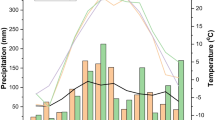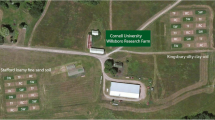Abstract
Switchgrass (Panicum virgatum) is a C4 perennial grass and is the model herbaceous perennial bioenergy feedstock. Although it is indigenous to North American grasslands east of the Rocky Mountains and has been planted for forage and conservation purposes for more than 75 years, there is concern that switchgrass grown as a biofuel crop could become invasive. Our objective is to report on the invasion of C4 and C3 grasses into the stands of two switchgrass cultivars following 10 years of management for biomass energy under different N and harvest management regimes in eastern Nebraska. Switchgrass stands were invaded by big bluestem (Andropogon gerardii), smooth bromegrass (Bromus inermis), and other grasses during the 10 years. The greatest invasion by grasses occurred in plots to which 0 N had been applied and with harvests at anthesis. In general, less grass encroachment occurred in plots receiving at least 60 kg of N ha−1 or in plots harvested after frost. There were differences among cultivars with Cave-in-Rock being more resistant to invasion than Trailblazer. There was no observable evidence of switchgrass from this study invading into border areas or adjacent fields after 10 years of management for biomass energy. Results indicate that switchgrass is more likely to be invaded by other grasses than to encroach into native prairies or perennial grasslands seeded on marginally productive cropland in the western Corn Belt of the USA.



Similar content being viewed by others
Abbreviations
- CRP:
-
Conservation Reserve Program
- C3 :
-
Cool-season grasses
- C4 :
-
Warm-season grasses
References
Raghu S, Anderson R, Daehler CC, Davis A, Wiedenmann R, Simberloff D, Mack R (2006) Adding biofuels to the invasive species fire? Science 313:1742
Mitchell RB, Vogel KP, Schmer, MR (2012) Switchgrass (Panicum virgatum) for biofuel production. Sustainable Ag Energy Community of Practice, eXtension. (http://extension.org/pages/Switchgrass_for_Biofuel_Production)
McLaughlin SB, Walsh ME (1998) Evaluating environmental consequences of producing herbaceous crops for bioenergy. Biomass Bioenergy 14:317–324
Schmer MR, Vogel KP, Mitchell RB, Perrin RK (2008) Net energy of cellulosic ethanol from switchgrass. Proc Natl Acad Sci U S A 105(2):464–469
Vogel KP, Brejda JJ, Walters DT, Buxton DR (2002) Switchgrass biomass production in the Midwest USA: harvest and nitrogen management. Agron J 94:413–420
Mitchell RB, Vogel KP, Sarath G (2008) Managing and enhancing switchgrass as a bioenergy feedstock. Biofuels Bioprod Biorefin 2:530–539
Ellstrand NC, Schierenbeck KA (2000) Hybridization as a stimulus for the evolution of invasiveness in plants? Proc Natl Acad Sci U S A 97:7043–7050
California Interagency Noxious Weed Coordinating Committee (2007) New CDFA plant pest ratings list released. Noxious Times 8(4):7–9
DiTomaso J, Barney J, Fox A (2007) Biofuel feedstocks: the risk of future invasions. Council for Agricultural Science and Technology (CAST) Commentary QTA 2007-1. CAST, Ames, IA. 8 pp
DiTomaso J, Holt J, Jackson N (2007) Biofuels and invasive plant species. Weed Science Soc. America (http://wssa.net/wp-content/uploads/BIOFUEL_AND_INVASIVES_white_paper.pdf). 1 p
GISP (2007) Assessing the risk of invasive alien species promoted for biofuels. Global Invasive Species Programme, Nairobi, Kenya. 6 pp. (http://wssa.net/wp-content/uploads/GISP-biofuels-062707.pdf)
Riefner R, Boyd S (2007) New records of wetland and riparian plants in Southern California, with recommendations and additions to the national list of plant species that occur in wetlands. J Bot Res Inst Texas 1:719–740
DiTomaso J, Barney J, Mann J, Kyser G (2013) For switchgrass cultivated as biofuel in California, invasiveness limited by several steps. Calif Agric 67(2):96–103
Casler MD, Vogel KP, Taliaferro C, Ehlke N, Berdahl N, Brummer EC, Kallenbach R, West C, Mitchell R (2007) Latitudinal and longitudinal adaptation of switchgrass populations. Crop Sci 47:2249–2260
Barney J, DiTomaso J (2008) Non-native species and bioenergy: are we cultivating the next invader? Bioscience 58:64–70. doi:10.1641/B58011
Parrish DJ, Fike J (2005) The biology and agronomy of switchgrass for biofuels. Crit Rev Plant Sci 24:423–459
Follett RF, Vogel KP, Varvel G, Mitchell R, Kimble J (2012) Soil carbon sequestration by maize and switchgrass grown as bioenergy crops. Bioenergy Res 5:866–875
Schmer MR, Vogel KP, Varvel G, Follett R, Mitchell RB, Jin V (2014) Energy potential and greenhouse gas emissions from bioenergy cropping systems on marginally productive cropland. PLoS ONE 9(3), e89501. doi:10.1371/journal.pone.0089501
SAS Institute (2006) The SAS system for Windows. Version 9.2. SAS Inst, Cary
Redfearn DD, Moore KJ, Vogel KP, Waller SS, Mitchell RB (1997) Canopy architecture and morphology of switchgrass populations differing in forage yield. Agron J 89:262–269
Tilman D, Wedin D (1991) Dynamics of nitrogen competition between successional grasses. Ecology 72:1038–1049
Mitchell RB, Masters RA, Waller SS, Moore KJ, Young LJ (1996) Tallgrass prairie vegetation response to spring burning dates, fertilizer, and atrazine. J Range Manag 49:131–136
Gillen RL, Berg WA (2005) Response of perennial cool-season grasses to clipping in the Southern Plains. Agron J 97:125–130
Author information
Authors and Affiliations
Corresponding author
Additional information
K.P. Vogel retired from USDA-ARS in November 2013.
Rights and permissions
About this article
Cite this article
Mitchell, R.B., Vogel, K.P. Grass Invasion into Switchgrass Managed for Biomass Energy. Bioenerg. Res. 9, 50–56 (2016). https://doi.org/10.1007/s12155-015-9656-4
Published:
Issue Date:
DOI: https://doi.org/10.1007/s12155-015-9656-4




